June 2013 LIP of the Month
The Meso-Archaean Pongola Supergroup in South Africa and Swaziland – The oldest known large igneous province on stable continental crust?
Allan Wilson
School of Geosciences, University of the Witwatersrand, Johannesburg, South Africa
allan.wilson@wits.ac.za
Axel Hofmann
Department of Geology, University of the Johannesburg, Johannesburg, South Africa
ahofmann@uj.ac.za
Introduction
The Meso-Archaean Pongola Supergroup is an exceptionally well preserved sequence of volcanic and sedimentary rocks that extends as a linear belt in a north-south direction for 270 km in SE South Africa (Fig. 1). Its characteristics are unique amongst supracrustal terrains of this age and unlike those of Archaean greenstone belts. It occurs as a continuous, but in some areas relatively poorly preserved, series of inliers surrounded by younger strata close to the eastern margin of the Kaapvaal Craton. The unique character of the Pongola Supergroup is that it formed at the transition in southern African crustal development from an early Archaean granitoid-greenstone setting, exemplified by the Barberton Mountainland, to late Archaean stable crustal basin formation. It is also correlated (at least for the sedimentary component) with the intracratonic Witwatersrand Supergroup of similar age.
The sequence was deposited in a stable continental environment with extensive epicratonic volcanism and basin sedimentation. The volcanic assemblages are unique at this time in Earth’s history with a substantial proportion being intermediate andesites with a strong crustal chemical and isotopic signature (Hegner et al., 1984). Previous studies (Burke et al., 1985) have suggested similarities of the Pongola depositary to present-day continental rifts on the basis of lithostratigraphy, the nature of the sedimentary deposits and a bimodal distribution of volcanic rocks. However, recent detailed studies indicate a more complex setting, and possibly one with no precise similarities in the present day, but one which attests to extensive and widespread volcanism. The extent and diversity of volcanic rocks and the contrast to greenstone belt volcanism places the Pongola succession in contention as the world’s oldest Large Igneous Province located on stable continental crust.
Distribution of the Pongola Rocks
The Pongola Supergroup developed as two separate basins (Gold, 2006), delineated as the Northern and Southern Domains and into distinct geographic regions: north, central, south, and the Nkandla region in the far south (Fig. 1). The north and central regions extend into western Swaziland. The Nkandla region in the far south has been highly deformed due to major folding and borders on the late Proterozoic Natal-Namaqua metamorphic belt (Jacobs and Thomas, 1994). In the south region of the Northern Domain, and in the Nkandla region, the Pongola successions are exposed as distinct inliers, with specific names (see Fig. 1), which will be referred to throughout this article.
Stratigraphy and Regional Setting of the Pongola Supergroup
The Mesoarchaean Pongola Supergroup is made up of a predominantly volcanic lower section, the Nsuze Group, and an upper sedimentary Mozaan Group (Fig. 2). In the north and central regions of the Pongola Supergroup the Nsuze Group is estimated to be 4300 m thick (Gold, 2006) and comprises two major volcanic sequences with three minor sedimentary successions (Cole, 1994). The overlying 4800 m thick sedimentary Mozaan Group comprises dominantly arenaceous sediments with lesser argillaceous (including ferruginous) sediments. In some areas of the Mozaan Group a thick sequence of volcanic rocks forms part of the succession. In the most northern region in the vicinity of Amsterdam the succession is preserved in fault bounded blocks within a synformal structure. To the south, southwest and west of the town of Piet Retief the succession is attenuated and disturbed by major intrusions of the Usushwana mafic complex (Hammerbeck, 1982). The most complete and thickest succession of the Pongola Supergroup for both the Nsuze Group and the Mozaan Group is preserved in the central region east of the town of Paulpietersburg and is known as the Hartland area where the dip of the volcanic rocks is to the east at 20-40°. In the Southern Domain a series of persistent volcanic members occur both as lava flows and volcaniclastic rocks that are contained within the sedimentary sequences in three major synclines. The Southern and Northern Domains are separated by a major cratonic feature called the Melmoth Basement Arch (Fig. 1).
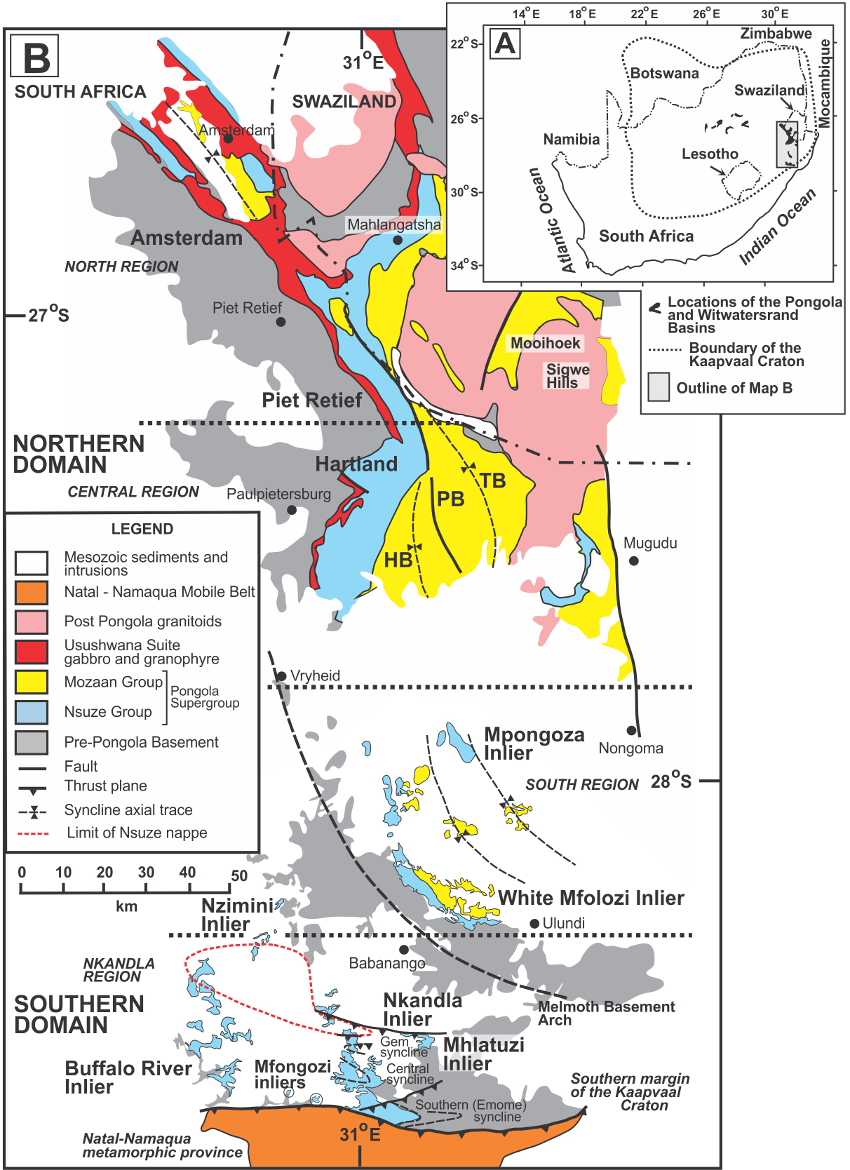
Figure 1. Extent of the Pongola Supergoup in the SE Kaapvaal Craton (Wilson et al., 2013). Note that on the basis of lithostratigraphic variation, outcrops have been subdivided into a Northern Domain, consisting of a north, central and south region, and a Southern Domain.
Geochronology of the Pongola Supergroup and the Basement Rocks
The Pre-Pongola basement has been accurately dated at a number of localities. In the Amsterdam area the basal rocks of the Nsuze Group were emplaced on granodiorite of the Mpuluzi Batholith dated at 3107 +4/-2 Ma (Kamo & Davis, 1994). Recent precise ages of the Anhalt trondhjemite suite located several kilometers east of Piet Retief is dated at 3222±8 Ma and 3193±5 Ma (Saha et al., 2010).
As far as dating of the Pongola Supergroup is concerned, Hegner et al. (1994) obtained the most precise age on a basaltic andesite in the Mhlangatsha area in Swaziland (Fig. 1) of 2985 ±1 Ma. The most recent U-Pb isotopic age determinations of the Pongola volcanic rocks (Mukasa et al., 2013) using SIMS on zircons give a logical progression of ages from the base of the Nsuze Group in the Hartland area of 2980±10 Ma, to a rhyolite in the mid-sequence of 2968±6 Ma and an age in the upper part of the Mozaan Group (Tobolsk volcanics) of 2954±9 Ma. Based on that work the period of emplacement of the entire Pongola Supergroup is indicated to be of short duration, possibly as short as 30 m years, but confirmation of the definitive Tobolsk age is necessary because of the possibility of inherited zircons in that study. Younger ages were determined on the Mozaan Group from previous studies. A minimum age of 2837±4.7 Ma was established for a quartz porphyry sill that intruded Mozaan Group strata in southern Swaziland. Also intrusive into the Pongola Supergroup are undeformed “post-Pongola granites” which typically fall in the age range between 2.8 and 2.7 Ga (Mukasa et al., 2013 and references therein). A major mafic intrusion (the Usushwana Complex) is an integral part of the magmatism associated with the Pongola Supergroup and which it intrudes at many localities in the north. While previous age determinations gave c. 2875 Ma (e.g. Hegner et al., 1984), most recent baddeleyite U-Pb data indicate emplacement ages of 2989.2±0.8 Ma and 2989.8±1.7 Ma (Olsson, 2012). On this basis the Usushwana Complex must be regarded as a possible early – stage magma chamber associated with the eruption of the mafic lavas of the Nsuze Group pointing to widespread magmatism over a duration of c. 30 Ma.
Volcanic Sequences of the Pongola Supergroup
The thickest successions of both the Nsuze and Mozaan Groups occur in the Hartland area (Fig. 1) in the Northern Domain. The Nsuze Group in this area has been mapped in detail by numerous workers (Armstrong, 1980, Armstrong et al., 1982, Cole, 1994, Gold, 1993, Grant, 2003, Linström, 1987). In this area three structurally controlled basins are recognized (Watchorn, 1978) arranged in a series of broad antiforms: in the southwest is the Hartland Basin (HB), to the east the Piensrand Basin (PB) and in the northeast the Tobolsk Basin (TB). The dominantly volcanic rocks of the Nsuze Group in this area are in the western synformal limb of the Hartland Basin.
Stratigraphic Subdivision and Nomenclature
While there exists a great many variations to the suggested lithological units in the literature over the previous 40 years, as well as in the naming of lithostratigraphic units and their correlations throughout the Pongola belt, in the most recent publication on Pongola stratigraphy (Gold, 2006), the Nsuze Group is divided into three subgroups but has subsequently been modified on the basis of recent field studies by Wilson et al. (2013) shown in Fig. 2.
The volcanic Bivane Subgroup is divided into 3 formations with the lowest being the volcanic Pypklipberg Formation (Armstrong, 1980), from the area in which the distinctive rhyolite unit is located. The upper and lower volcanic units of the Bivane Subgroup are separated by a discontinuous volcaniclastic unit that may possibly be correlated with the White Mfolozi Formation from the type area in the south of the Northern Domain. The upper Agatha Formation comprises volcanic rocks of the entire compositional range from basalt to rhyolite but is mainly basaltic andesite and andesite. A distinctive and persistent felsic pyroclastic layer (10 - 40 m thick) near the top of the Agatha Formation is called the Ntambo Member.
Lithologies of the Nsuze Group
The lowest unit of the Pongola Supergroup is the Wagendrift Formation (400 m thick) comprising predominantly non-porphyritic basalt with flow units 1 – 3 m in thickness and minor sandstones lenses. The basalt consists of subaerial sheet flows and sparse pillows, the latter indicating local subaqueous emplacement conditions. It unconformably overlies the granite basement on the west side and is intruded by mafic rocks of the Usushwana Complex on the east side. A distinctive palaeosol 2 – 10 m thick and formed from deep in-situ weathering of granite is locally developed (Grandstaff et al., 1986, Matthews & Scharrer, 1968).

Figure 2. Lithostratigraphy of the Pongola Supergroup (after Gold (2006) modified by Wilson et al., 2013).
Towards the southwest, the basalts of the Wagendrift Formation interfinger with sediments of the Mantonga Formation. The mainly siliciclastic Mantonga Formation further develops southwards and is made up of coarse grained wackes, arkosic arenites and sporadic conglomerates developed mainly in the lower part of the succession. Lava flows (5 - 40 m in thickness) range in
composition from basalt through to andesite and dacite. Air-fall tuffs and agglomerates are also present in thicknesses up to 40 m. The tuffs typically contain lithic fragments and flattened pumice fragments (fiammé). Bombs and lapilli are present in the clastic rocks indicating contemporaneity of volcanism with sedimentation (Watchorn & Armstrong, 1980). The sedimentary rocks indicate rapid, shallow water, high energy deposition and the volcanic rocks show strong evidence of reworking indicating overall a shallow subaqueous continental shelf or transient submarine environment.
The main successions of lava flows are contained within the Pypklipberg and Agatha Formations of the Bivane Subgroup and are made up of flows of basalt, basaltic andesite, andesite, dacite and rhyolite. Agglomerate units contain bomb ellipsoidal fragments 10 - 30 cm in length and cemented in a matrix of broken bomb and rounded fragments. Pyroclastic breccias contain angular fragments moulded and broken against adjacent fragments. The rhyolites in many cases appear massive and exhibit flow banding but recrystallization and devitrification in some cases may have obscured the original ash textures.
The distribution of the lava compositions is shown in Fig. 3 for SiO2 and MgO contents. The bimodal distribution of compositions is apparent but there is a significant proportion of intermediate compositions that contrasts with compositional distributions typical of later continental flood volcanism (Ewart et al., 2004, Hooper, 1997, Peate, 1997).
The Ntambo Member is a narrow but persistent (extending for 16 km) volcaniclastic unit that contains dacite and rhyolite fragments within a matrix of ash, devitrified glass shards and compressed pumice fragments. Andesites and basaltic andesites in the upper Agatha Formation are both aphyric and porphyritic and commonly occur in close association with no chills between them (Fig. 4) indicating simultaneous and probably rapid eruption of different magmas. Rhyolites show strong flow banding and devitrification textures.

Figure 3. Distribution of volcanic compositions for %SiO2 and %MgO (anhydrous) in the Northern Domain (Wilson et al., 2013).
The Mozaan Group
The stratigraphy of the Mozaan Group is shown for the entire Pongola Supergroup in the Hartland type area (Fig. 2) and is made up of three subgroups and ten formations (Beukes & Cairncross, 1991, Gold, 2006, Young et al., 1998). The Mozaan Group is a succession of clastic sediments, mainly sandstone and quartz wackes, together with subordinate but important ferruginous shales and siltstones. Two well-developed diamictite units are present in the Delfkom Formation and are regarded as glacial in origin (Von Brunn & Gold, 1993, Young et al., 1998). Two volcanic units, the Tobolsk and Gabela Formations (stratigraphic position shown in Fig. 2), occur towards the top of the Mozaan Group.
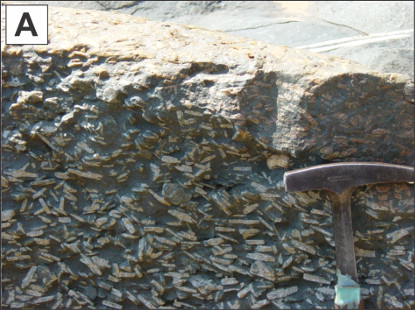

Figure 4. A. Typical porphyritic andesite in the Hartland area. B. Aphyric and highly porphyritic lavas in close association with no chills (Wilson et al., 2013).
Distribution of the Nsuze Group in the Northern Domain
The Amsterdam area is the most northerly preserved occurrence of the Pongola Supergroup (Fig. 1). It appears as two NW trending arms which are most likely fault bounded with the structure forming the limbs of a synform. Rock types include porphyritic andesite, basalt and rhyodacite. Further south in the Piet Retief area the succession is made up of highly attenuated slivers of volcanic and volcaniclastic rocks that have been affected by the intrusion of the Usushwana mafic intrusive suite. The Pongola succession in this area is mainly represented by volcanic rocks of the Nsuze Group (Hatfield, 1990), which extend into Swaziland and are intruded by post-Pongola A-type granites. Over 4000 m of Pongola stratigraphy is preserved in this area. The lower felsic volcanic unit (2500 m thick) is made up of dark grey rhyolite and dacite lavas of the Pypklipberg Formation. Dacite lavas contain abundant phenocrysts in a fine-grained siliceous matrix of devitrified glass. The upper volcanic unit (correlated with the Agatha Formation (Fig. 2)) is a 1200 m-thick succession of mainly porphyritic andesites intercalated with amygdaloidal basalts and basaltic andesites with a shallower dip to the east.
The Pongola Supergroup is exposed in three areas in western and west-central Swaziland. These are the Kubutu-Mooihoek area 50 km east of Piet Retief, the most northern occurrences in the Mahlangatsha-Ntungulu area and the eastern occurrence in the Sigwe Hills - Ngwavuma River area (Fig. 1).The entire succession of the Mozaan Group, apart from the three highest exposed formations, is exposed in the Kubutu-Mooihoek and resting non-conformably on basement granite gneiss (Nhleko, 2003). The top of the succession in this area is the basaltic andesites of the Tobolsk Formation (Mhlanga, 2002, Nhleko, 1998, Nhleko, 2003). The lavas are dominated by flow units of basalt to basaltic andesite with pillows with narrow layers of tuffaceous andesites and rhyolite towards the top. In the lower part of the lava succession an ultramafic unit contains pyroxene spinifex and is one of the rare occurrences of ultramafic lava in the Pongola.
In the Mahlangatsha-Ntungulu area the lower unit of the Nsuze Group (Pypklipberg Formation) is preserved and records a total thickness of close to 3000 m of stratigraphy in this area. The lower lava unit comprises stacked flows of amygdaloidal basaltic andesite and the upper part is interlayered massive and amygdaloidal rhyodacite flows individually capped by narrow tuff layers (Nhleko, 2003). The south-east limit of the Pongola Supergroup, with the volcanic Tobolsk Formation in Swaziland is preserved in the Sigwe Hills (Fig. 1) and is estimated to be approximately 800 m thick (Mabuza, 1993). The lavas are dark grey, non-pillowed, with massive amygdaloidal flows. A rhyolite unit is sporadically developed in the lower part of the upper andesitic unit.
To the north of the White Mfolozi Inlier (Fig. 1) are several small inliers of Pongola rocks within the Karoo sediments. The largest occurrence is the Mpongosa Inlier that shows some of the best preserved and varied sequences of pyroclastic volcanism known in the Archaean (Preston, 1987). Clastic sediments are a minor component of the inlier. Von Brunn (1974) previously described a succession of alternating argillaceous and arenaceous sedimentary rocks in the Mpongosa Inlier and suggested a shallow marine-tidal flat environment with temporary influxes of fluviatile sediment (Von Brunn, 1974, Von Brunn & Hobday, 1976). The rocks are essentially undeformed although extensively altered in places. The volcanic phases preserve outstanding examples of pyroclastic deposits including classic ignimbrite sequences. The Mpongoza Inlier is subdivided into a Lower Volcanic Unit, an intermediate Sedimentary Succession and an Upper Volcanic Unit (Preston, 1987) . Subaerially deposited basalts and basaltic andesites occur in the lower parts of the volcanic successions. Predominantly ignimbrite flows of rhyodacite composition that overly basalt units are in turn overlain by thick pumice layers. Correlation is inferred with the Hartland area even though the amount of silicic pyroclastic rocks is significantly higher in the Mpongoza inlier.
A feature common to the felsic ignimbrites in both the Lower and Upper Volcanic Units is the presence of lithophysae (possibly the oldest known occurrence), which are cavities now filled with secondary minerals (mainly quartz, calcite, epidote and amphibole) which were caused by expanding gases in the tuffs before solidification (Breitkreuz, 2013).
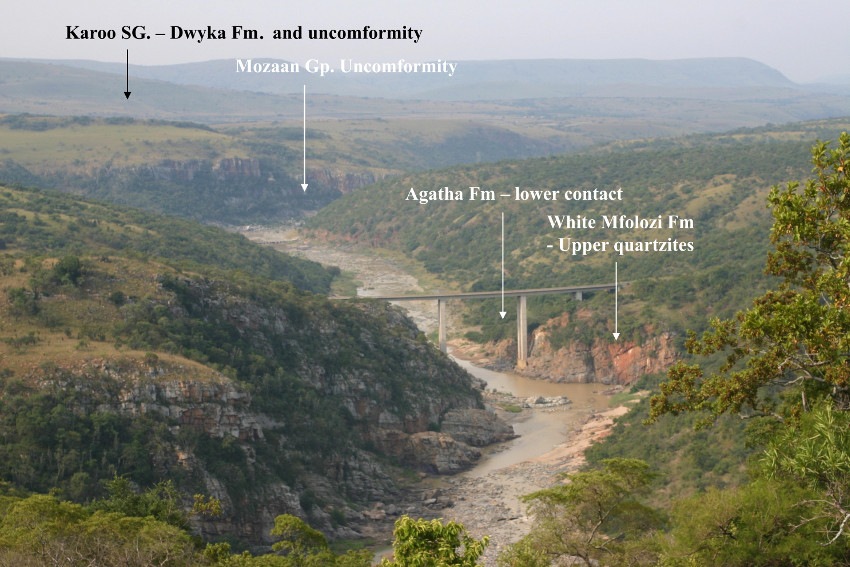
Figure 5. View to the east in the White Mfolozi River valley showing the contacts and extents of the upper formations.
The White Mfolozi Inlier is the most southerly occurrence of the Pongola Supergroup in the south region of the Northern Domain (Fig. 1). It is arguably one of the finest examples of preserved Archaean stratigraphy because of the variety of the volcanic and sedimentary rocks and the almost continuous exposure for 8 km along the White Mfolozi River, which has incised a deep gorge into the rocks (Fig. 5). In the White Mfolozi River gorge the complete Nsuze Group, as it occurs in this area, is exposed.
Initial mapping of the White Mfolozi Inlier by Matthews (1967) gave rise to the first stratigraphic subdivision of the sequence with subsequent modifications by Cole (1994), Wilson and Grant (2006) and Hicks and Hofmann (2012). The combined contributions of these works together with mapping in the present study are shown in Fig. 6. There is no precise correlation of volcanic (nor sedimentary) units to the north but in keeping with most other areas of the Nsuze Group it is characterized by a sedimentary unit bounded top and bottom by volcanic successions. The lower volcanic Nhlebela Formation (correlated with the Pypklipberg Formation in the type area of Fig. 2) varies in thickness from 40 – 180 m. The sedimentary and volcaniclastic White Mfolozi Formation is 480 m thick. The overlying volcanic Agatha Formation is highly variable in thickness ranging from over 1000 m to complete absence over a distance of less than 4 km and attests to highly irregular and deeply eroded pre-Mozaan topography.
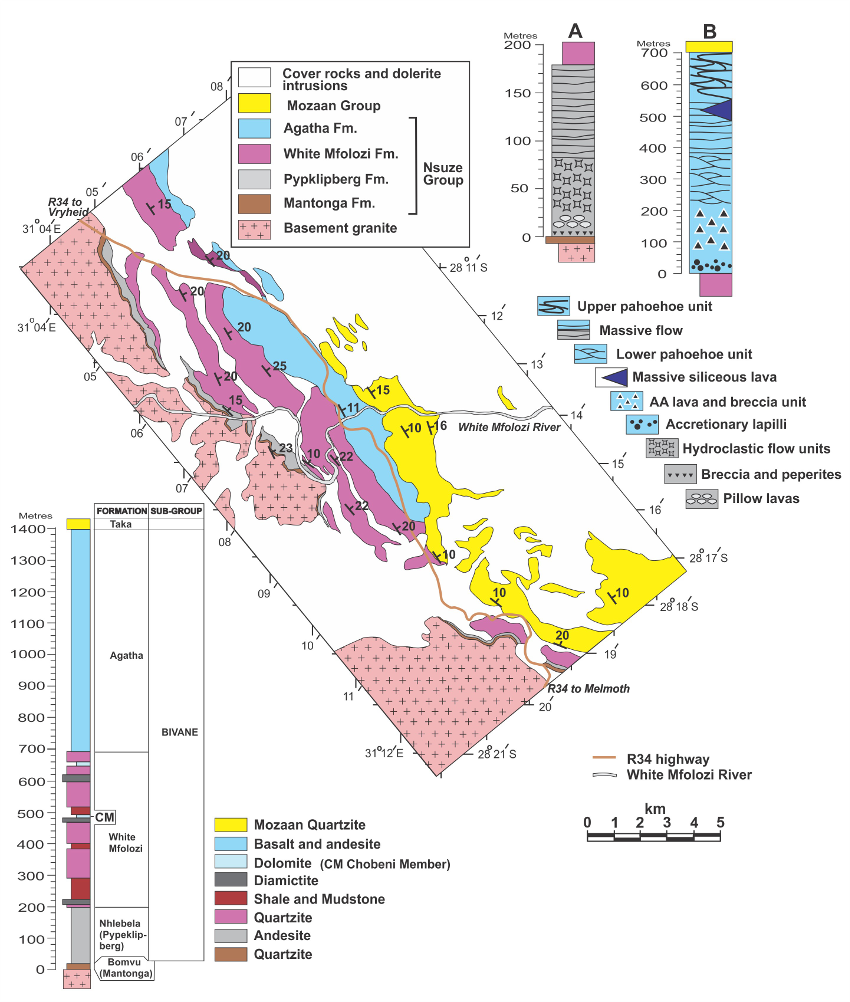
Figure 6. Geological map of the White Mfolozi Inlier after Matthews (1967) modified by Wilson et al. (2013).
The interaction of basal sediments with overlying volcanic rocks in the lower part of the Nhlebela Formation feature some of the best preserved examples of hydroclastic volcanic breccias (Wilson and Grant, 2006) in the Archaean period. Examples of the volcanic textures are shown in Fig. 7. Well-developed endogenous pépérites show jigsaw fit textures where lava has interacted with wet sediments. These are overlain by 20 m of well-developed pillows of andesitic composition which accounts for their large size. An 80 m- thick unit of irregular to tabular bulbous hydroclastic flow units of andesite to dacite occurs above the pillows. Partly broken pillows with well fitted pieces are intermediate between pillows and pillow breccias. The upper part of the Nhlebela Formation is made up of subaerial flow units of amygdaloidal basaltic andesite with well-developed chilled flow contacts, some with narrow hyaloclastite zones.
The White Mfolozi Formation comprises fluvial to shallow-marine quartzites, diamictites of mass-flow origin, shales, intertidal dolomites and minor volcaniclastic rocks (Fig. 8). A well-developed stromatolite unit with elongated domal biostromes occurs within dolomites of the Chobeni Member (Beukes & Lowe, 1989) and ranks among the best preserved biogenic structures in the mid-Archaean.
The upper volcanic Agatha Formation overlies the quartzite unit with a transitional zone 5 cm to 2 m thick consisting of volcanic fragments with tapered ends resembling compressed pumice particles (fiammé) and are also interspersed with layers of accretionary and armoured lapilli (Wilson & Grant, 2006). Some of the quartz grains are sharply fragmented indicating fracturing in an explosive volcanic environment.
The overlying 180 m of basaltic andesite volcanic units are mainly fragmental with superbly preserved successions of aa lava and breccias and overlain by laterally continuous and well-defined lava flows with amygdales developed close to the upper and lower contact with massive interiors. The top surfaces of the flow units have spectacularly developed ropey lava surfaces and probably the best preserved examples of this texture in volcanic rocks of this age (Fig. 9). Volcanic structures include lava break-outs, tumulus formation, terminated lava toes and rafted flow-top fragments. Sixteen lava flows of this type are recorded on the north bank of the White Mfolozi River and 29 flow units on the south bank (Wilson & Grant, 2006).
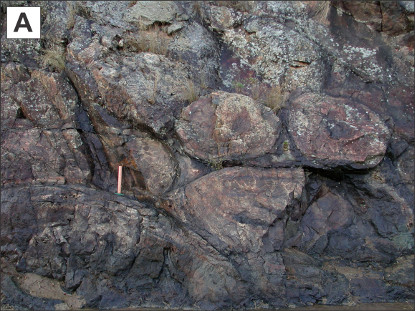
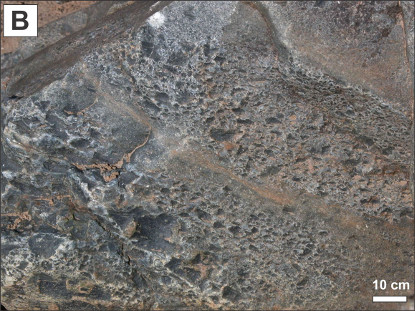
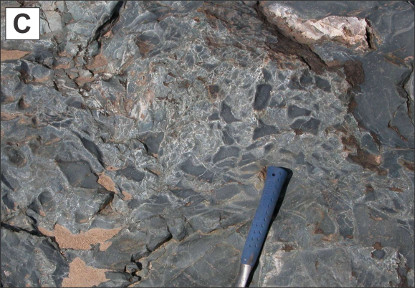
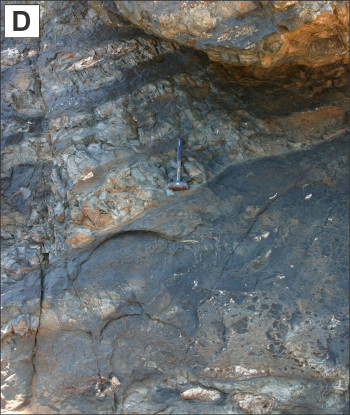
Figure 7. Volcanic types in the Nhlebela Formation of the White Mfolozi Inlier. A. Basal pillow unit of basaltic andesite to andesite. B. Fragmental lavas and pépérite with sand layers. C. Hydroclastic fragmentation of basaltic andesite lavas. D. Layered andesitic lavas and lava fragments.
This section is overlain by massive and relatively poorly defined flow units 130 m thick but notable for a domed and unstructured lava unit of more siliceous (and also more Mg-rich) lava on the south bank (Wilson & Grant, 2006). The uppermost unit as exposed in the White Mfolozi River is 120 m of relatively thin (1 -2 m thick) of highly amygdaloidal interdigitating pahoehoe
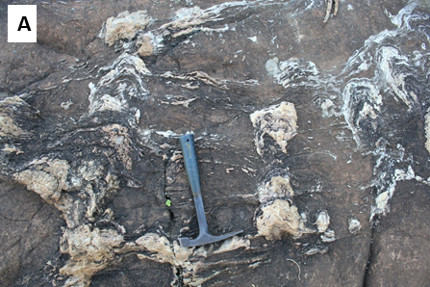
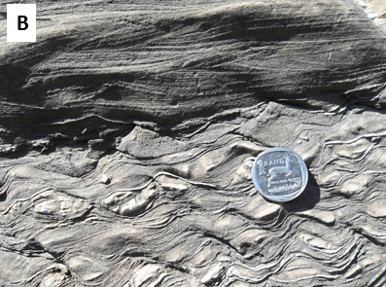
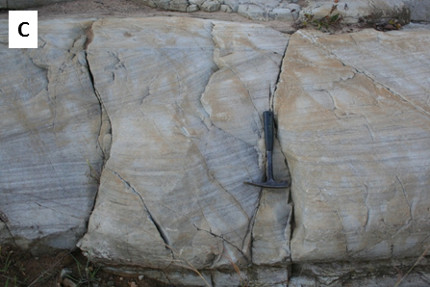
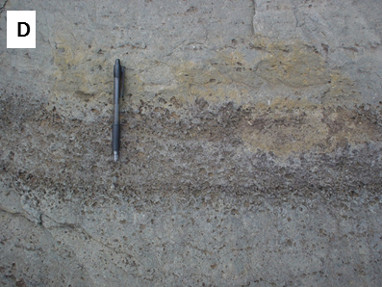
Figure 8. Lithologies of the White Mfolozi Formation. A. Stromatolitic dolomite. B. Wave-ripple aminated dolomitic arenite. C. Cross-bedded shallow-marine quartzite. D. Crudely planar-stratified air-fall lapillistone.
lava flows that give the impression of bulbous pillows in one dimension but are seen as terminating subaerial flows in the opposing direction and are most likely pahoehoe flows extruded into a shallow body of water as described by Self et al. (1997). The lava lobes commonly have multiple vesicle layers indicating repeated influxes of magma (Fig. 10). Compositional ranges for selected major and trace elements are shown in Fig. 11 covering the range from basalt to dacite.
Volcanic Sequences within the Mozaan Group
The volcanic Tobolsk Formation is an important component of the Mozaan Group. The unit is thin in the western extremity but increases in thickness towards the east and south-east, possibly up to 1000 m thick in the Nongoma area where it is largely covered by sediments of the Karoo Supergroup. It has been intersected by deep diamond drilling. It consists of amygdaloidal andesite flow units with minor dacite and felsic volcanic breccias. Ultramafic ash deposits and a rare flow unit of komatiitic composition occur at the top of the succession.
Distribution of the Nsuze Group in the Southern Domain
There are five main occurrences of the Pongola Supergroup in the Southern Domain that lie south of the Melmoth Basement arch (Fig. 1). There is little current agreement on the
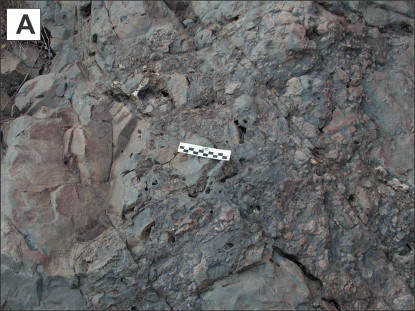
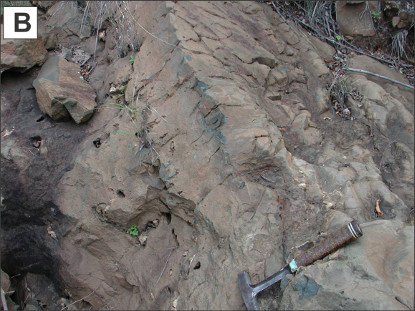
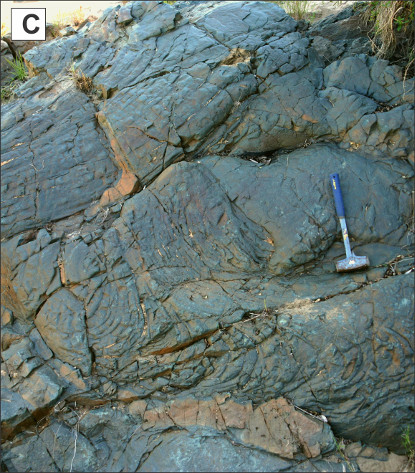

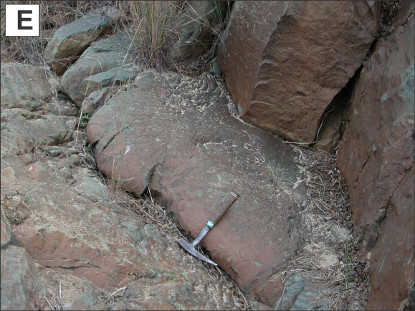
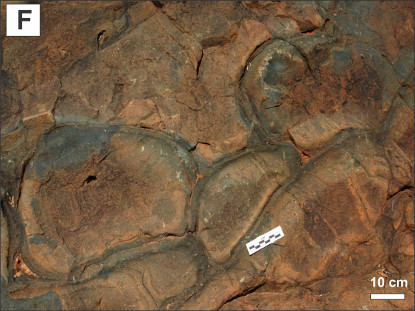
Figure 9. Volcanic textures in the Agatha Formation (Wilson et al., 2013). A. aa lava lobe with massive interior. B. Upper surface of a basalt flow lobe showing the thick fractured upper crust with pahoehoe surface. C. Interacting basalt flow lobes with pahoehoe surfaces and lava break-outs (top centre and lower). D. Ropey lava surface. E. Lava toe with overlying columnar jointed flow lobe. F. Pahoehoe flow lobes that were probably emplaced in shallow water.
stratigraphy and correlations are not fully understood because of the structural complexity and limited exposure. Distinct lithological markers have assisted in this regard.
The Nkandla Inlier (Fig. 1) is the most studied and is broadly representative of the other successions in the Southern Domain. The succession has undergone intense deformation with three large synclinoria developed with axial planes aligned NNE with each of the structures separated by tectonic mélanges. The volcanic-sedimentary successions in the Nkandla Inlier vary widely in thickness (Groenewald, 1984). Two dominantly volcanic sequences are present in the Nkandla area and these are preserved in the Central and Gem-Vuleka Synclines. The most extensive succession of basalts and basaltic andesites is exposed as the Qudeni Formation which in this area is 700 m thick and occur as subaerial flow units 2 – 16 m in thickness with amygdales developed in the top and base of the flows. Units made of the basaltic andesite pillows are present in rare occurrences. A succession of pyroclastic rocks (including crystal-bearing lapilli tuffs and agglomerates), volcanogenic sediments, quartz arenites and rare argillite layers with minor intercalations of amygdaloidal lava and banded iron formation constitute the Ndikwe Formation which has no equivalent elsewhere in the Pongola Supergroup. Although Groenewald (1984) regarded this unit as the earliest stage of the Nsuze Group, on structural grounds Matthews (1990) considered it as an allochtonous assemblage that forms part of the Nsuze Nappe extending to the west rather than part of the autochtonous Pongola succession (shown in Fig. 1). An important aspect of the Ndikwe Formation is the presence of ultramafic ash and pyroclastic rocks even though there are no preserved komatiite flows.
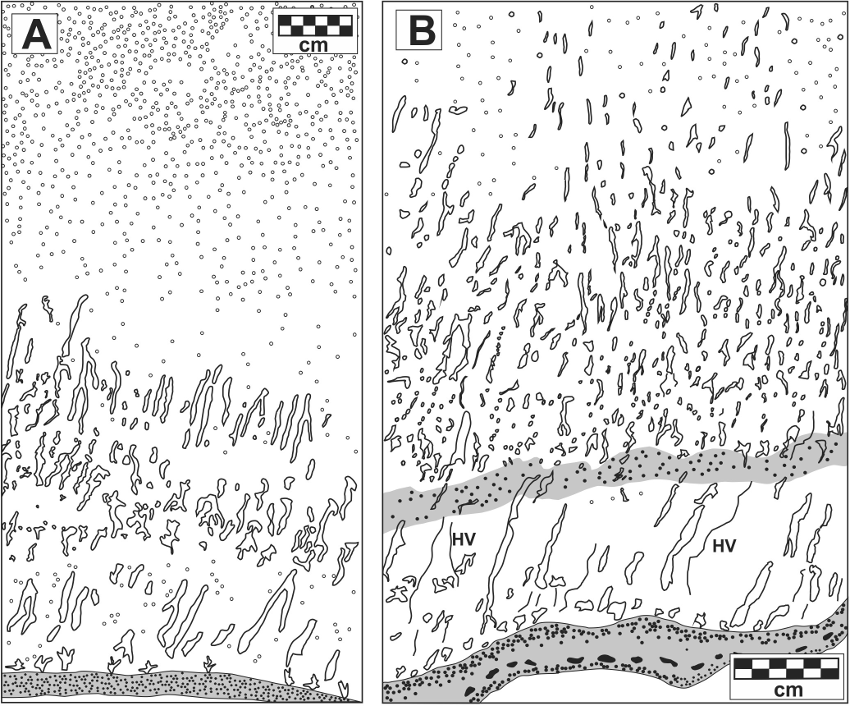
Figure 10. Vesicle structures in the Mg-andesites of the Agatha Formation showing evidence of repeated infilling and flow through the same lobe (after Wilson and Grant, 2006). In B healed vesicle track is HV.
The Hlagothi Intrusive Suite in the Nkandla Area
Du Toit (1931) recognized and named a suite of major layered intrusions and sills in the northern Nkandla area the Hlagothi Igneous Complex. The lower section is made up of olivine cumulates grading into wherlites and pyroxenites and is capped by gabbroic rocks. The upper contact is a complex succession of chills and skeletal pyroxene textures in both branching and random forms (Groenewald, 1984). Groenewald (1984) suggested the parental magma composition was possibly komatiitic. An U-Pb isotopic study on baddeleyite in the Hlagothi Complex from an area in the Nsuze River gives an age of 2866±2 Ma (Gumsley et al., 2013) indicating large volume magmatism up the final stages of development of the Pongola basin.
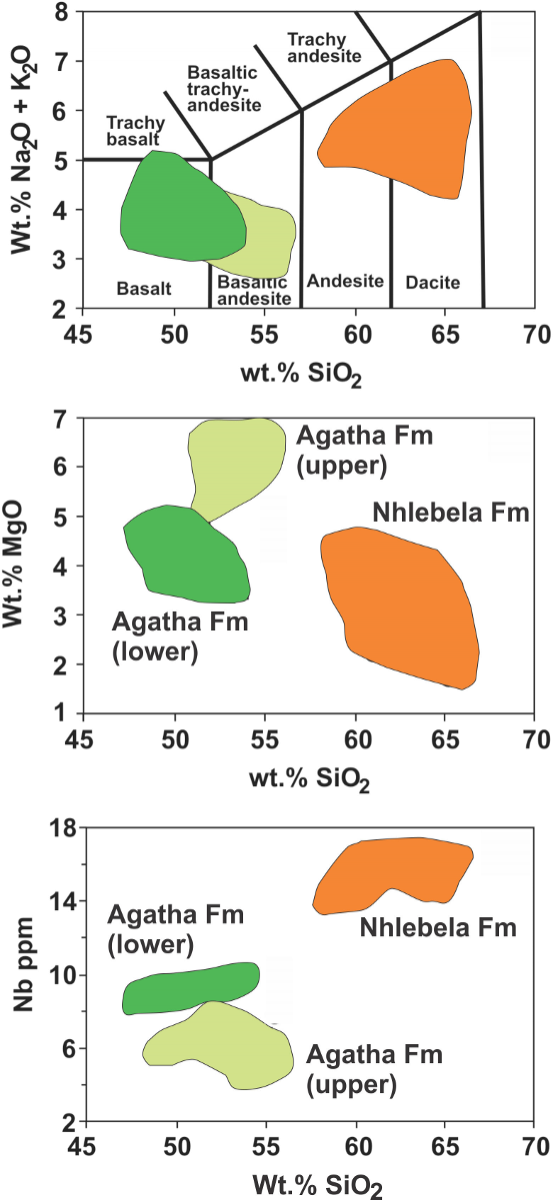
Figure 11. Selected elements of the compositional range of the volcanic rocks in the White Mfolozi Inlier.
Distribution of the Volcanic Rock Series and Lateral and Vertical Variation of Depositional Facies
There is a progression of volcanic associations from south to north in the exposed areas of the Pongola Supergroup. In the Amsterdam, Piet Retief and Hartland areas rhyolite and dacite (volcaniclastics and lava flows) make up a significant proportion of the lithologies but felsic volcanic units diminish to the south. The Mpongoza inlier is made up of dominantly felsic pyroclastics (mainly high temperature ignimbrites), but there is a marked change in the White Mfolozi inlier where rhyolites are absent (Wilson & Grant, 2006), although the andesite-dacite range of volcanic rocks is present in the lower Nhlebela Formation. In the Southern Domain occurrences of felsic volcanic rocks reported are minimal by comparison. In the Ndikwe Formation ultramafic volcanism is evidenced by the occurrence of bomb fragments and ultramafic volcaniclastic sequences. Basalts are also of generally limited extent and basaltic andesites through to andesite occur in all areas and represent about 70% of volcanic compositions.
Evidence in the northern Hartland area points to mainly subaerial volcanism but there are also indications of pillow structures and to at least local reworking of ash deposits indicating some subaqueous deposition. True submarine pillows are found only at the base of the Nhlebela Formation whereas other pillow structures (such as in the Hartland area and the top of the Agatha Formation in the White Mfolozi Inlier) are essentially pahoehoe lobes that formed locally in lacustrine environments or flooded river valleys (Self et al., 1997). There is no evidence of extensive submarine deposition of the basalts and intermediate volcanic rocks. The pillows observed at the base of the Nhlebela Formation in the White Mfolozi Inlier change vertically to highly amygdaloidal flow lobes with intense hydroclastic fragmentation, then to units with pahoehoe tops characteristic of subaerial volcanism. Abundant hyaloclastites and breccias are indicative of shallow water subaqueous hydroclastic eruption intermediate between pillow formation and subaerial pahoehoe flows.
Other Pongola Related Magmatism
Evidence of magmatism that was also related to the Pongola event is found in dyke swarms in the Badplaas area (in the vicinity of the Barberton greenstone belt) 50 km north of the present northerly extremity of known Pongola volcanism, but with the same age as the Agatha Formation (Olsson et al., 2010). It may therefore be inferred with some confidence that the Pongola Supergroup extended for a considerable distance but has now been removed completely by erosion. In addition, the bimodal (basalt to rhyolite range) volcanic Dominion Group (Marsh, 2006) that immediately underlies the sediments of the Witwatersrand Supergroup has been tentatively correlated with the Nsuze Group (Beukes & Cairncross, 1991, Gold, 2006). The currently accepted age for the Dominion Group is 3074±6 Ma (Armstrong et al., 1991) is considerably older than ages obtained to date for the Nsuze Group volcanics. However, strong tectonic and lithological similarities exist between these two major volcanic occurrences and on this basis the extension of the Dominion Group – Nsuze Group would greatly enlarge the aerial extent of the volcanic province.
The Origin and Tectonic Setting of the Pongola Supergroup
Although the distribution of volcanic rock series is currently 270 km along the eastern side of the Kaapvaal Craton, the original depositary was most likely much larger and could have involved volcanism as far north as Barberton and also as far west as the first volcanic stage of the Witwatersrand Supergroup. The eastern margin of the belt was subsequently truncated firstly by post-Pongola A-type granites and then by Gondwana fragmentation. The western limits are covered by Mesozoic Karoo sediments. Taking into account tectonic shortening in the Southern Domain and the possible extents of the basin, the entire Pongola basin could have had an aerial extent of between 50 000 - 90 000 km2.
The tectono-volcanic setting of the Pongola Supergroup needs to be seen in the context of basin morphology. The thickest section is in the Hartland area with the deposits thickening to the NE and to the S away from a NW-SE trending basement arch. No komatiite flow units are recorded in the Pongola Supergroup, but evidence of ultramafic volcanism is observed in the volcaniclastic deposits of the Southern Domain and associated with volcanic units in the Mozaan Group with the latter indicating a late-stage resurgence of primitive magmas possibly derived from the same mantle sources as the preceding greenstone belts.
The marked changes in the thickness of the volcanic units indicates that the entire Pongola basin was not likely to have been deposited in the same tectonic setting throughout. Tectonic interpretation suggests a control by N-S trending half grabens in the Northern Domain, while the dominantly E-W structures in the Southern Domain may have represented deposition in a subsiding epicratonic basin extending into a continental margin setting with evidence of intertidal sedimentation that is not present in the northern facies of the Nsuze Group.
The Pongola Supergroup as a Large Igneous Province
Parallels for the tectonic setting of the Pongola Supergroup in relation to those of modern and recent times remains uncertain. It represents the oldest known marginal continental to epicontinental volcano-sedimentary deposit with extensive volcanism which probably took place synchronously with alternating periods of intense erosion and sedimentation. The evidence of ultramafic volcanism in the south together with a lack of abundant felsic volcanics, but progressing into extensive pyroclastic volcanism further north, finally resulting in a bimodal volcanic suite (but also containing volcanics of intermediate composition) in the far north indicates a variable tectonic setting. This may be from a possible continental arc setting in the south to a continental rift zone with combined lithospheric thinning in the north. The preponderance of a wide range of volcanic rock types, together with a high proportion of basaltic andesite and andesite, volcanogenic and volcaniclastic sediments together with quartz wackes and greywackes is suggestive initially of magmatism and sedimentation in a continental arc setting eventually developing into a subsiding cratonic basin with ingestion of coarse clastic material that makes up the overlying Mozaan Group. Deposition in the Mozaan basin most likely formed as a result of wide-spread thermal subsidence of the continental and mantle lithosphere following the prolonged period of Nsuze magmatism.
The definition of what makes up a LIP has evolved continuously (Bryan & Ernst, 2008) since the first proposal of this class of igneous rocks (Coffin & Eldholm, 1992). The Pongola belt certainly has a large volume of volcanic rock as well as possible major intrusive phases. It may invoke a plate tectonic control for parts of the belt and it has a wide range of compositions from ultramafic to silicic. It is likely that each of the volcanic phases took place over a short period of time and the entire emplacement and depositional event could have been as short as 30 million years, but these bounding ages still need to be ascertained with certainty.
References
Armstrong, N. V. (1980). Geology and geochemistry of the Nsuze Group in northern Natal and southeastern Transvaal. PhD (unpublished), Pietermaritzburg: University of Natal, 386.
Armstrong, N. V., Hunter, D. R. & Wilson, A. H. (1982). Stratigraphy and petrology of the Archaean Nsuze Group, northern Natal and southeastern Transvaal. Precambrian Research 19, 75-107.
Armstrong, R. A., Compston, W., Retief, E. A., William, L. S. & Welke, H. J. (1991). Zircon ion microprobe studied bearing on the age and evolution of the Witwatersrand triad. Precambrian Research 53, 243-266.
Beukes, N. J. & Cairncross, B. (1991). A lithostratigraphic - sedimentological reference profile for the late Archaean Mozaan Group, Pongola Sequence: application to sequence stratigraphy and correlation with the Witwatersrand Supergroup. South African Journal of Geology 94, 44-69.
Beukes, N. J. & Lowe, D. R. (1989). Environmental control on diverse stromatolite morphologies in the 3000 Myr Pongola Supergroup, South Africa. Sedimentology 36, 383-397.
Breitkreuz, C. (2013). Spherules and lithophysae - 200 years of investigation on high-temperature crystallization domains in silica-rich volcanic rocks. Bulletin of Volcanology 75, 705-721.
Bryan, S. E. & Ernst, R. E. (2008). Revised definition of Large Igneous Provinces (LIPs). Earth-Science Reviews 86, 175-202.
Burke, K., Kidd, W. S. F. & Kusky, T. M. (1985). The Pongola structure of southeastern Africa: The World's oldest preserved rift? Journal of Geodynamics 2, 35-49.
Coffin, M. F. & Eldholm, O. (1992). Volcanism and continental break-up:a global compilation of large igneous provinces. In: Storey, B. C., Alabaster, T. & Pankhurst, R. J. (eds.) Magmatismand the Causes of Continental Break-up. London: Geological Society of London Special Publication, 17-30.
Cole, E. G. (1994). Lithostratigraphic and depositional environment of the Archaean Nsuze Group, Pongola Supergroup. MSc (unpublished), Johannesburg: Rand Afrikaans University, 166.
Du Toit, A.L. (1931). The Geology of the Country Surrounding Nkandhla, Natal. Department of Minerals and Mines of the Union of South Africa. Explanation to Sheet 109 (Nkandhla), 1-111.
Ewart, A., Marsh, J. S., Milner, S. C., Duncan, A. R., Kamber, B. S. & Armstrong, R. A. (2004). Petrology and geochemistry of early Cretaceous bimodal continental flood volcanism of the NW Etendeka, Namiba. Part 1: Introduction, mafic lavas and re-evaluation of mantle source compositions. Journal of Petrology 45, 59-105.
Gold, D. J. C. (1993). The geological evolution of the Pongola basin, southeastern Kaapvaal Craton. Pietermaritzburg: PhD (unpublished), University of Natal, 168.
Gold, D. J. C. (2006). The Pongola Supergroup. In: Johnson, M. R., Anhaeusser, C. R. & Thomas, R. J. (eds.) The Geology of South Africa. Johannesburg: The Geological Society of South Africa, 135-147.
Grandstaff, D. E., Edelman, M. J., Foster, R. W., Zbinden, E. & Kimberley, M. M. (1986). Chemistry and mineralogy of Precambrian paleosols at the base of the Dominion and Pongola Groups (Transvall, South Africa). Precambrian Research 32, 97-131.
Grant, C. E. (2003). The Physical Volcanology and Geochemistry of the Nsuze Group, Pongola Supergroup, of Northern KwaZulu-Natal and Southeastern Mpumalanga. MSc (unpublished), Durban: University of Natal, 165.
Groenewald, P. B. (1984). The lithostratigraphy and petrogenesis of the Nsuze Group, northwest of Nkandla, Natal. MSc (unpublished), Pietermaritzburg: University of Natal, 333.
Gumsley, A. P., de Kock, M. O., Rajesh, H.M., Knoper, M. W., Söderlund, U. & Ernst, R. E. (2013). The Hlagothi Complex: The identification of fragments from a Mesoarchaean large igneous province on the Kaapvaal Craton. Lithos 174, 333-348. Hammerbeck, E.C.I. (1982). The geology of the Usushwana Complex and associated formations - southeeastern Transvaal. Geol. Surv. S. Afr. Memoir 70, 119pp.
Hammerbeck, E.C.I (1982). The geology of the Usushwana Complex and associated formations, southestern Transvaal. Geological Survey of Souht Africa Memoir 70, 119pp.
Hatfield, R. A. (1990). The geology and structure of the Pongola Sequence east of Piet Retief , southeastern Transvaal. MSc (unpublished), Pietermaritzburg: University of Natal, 109.
Hegner, E., Kröner, A. & Hoffman, A. W. (1984). Age and isotope geochemistry of the Archaean Pongola and Usushwana suites in Swaziland, southern Africa: a case for crustal contamination of the mantle-derived magma. Earth and Planetary Science Letters 70, 267-279.
Hegner, E., Kröner, A. & Hunt, P. (1994) A precise U-Pb age for the Archaean Pongola Supergroup volcanics in Swaziland. Journal of African Earth Science, 18, 339-341.
Hicks, N., and Hofmann, A. (2012). Stratigraphy and provenance of the auriferous-uraniferous, fluvial to shallow-marine Sinqeni Formation, Mozaan Group, northern KwaZulu-Natal, South Africa. South African Journal of Geology 115, 327-344.
Hooper, P. R. (1997). The Columbia River flood basalt province: current status. In: Mahoney, J. J. & Coffin, M. F. (eds.) Large Igneous Provinces. Washington, DC: American Geophysical Union 1-27.
Jacobs, J. & Thomas, R.J. (1994). Oblique collision at 1.1 Ga along the southern margin of the Kaapvaal continent, SE Africa. Geologische Rundschau 83, 322-333.
Kamo, S. L. & Davis, D. W. (1994). Reassessment of Archean crustal devlopment in the Barberton Mountain Land, South Africa, based on U-Pb dating. Tectonics 13, 167-192.
Linström, W. (1987). Die geologie van die gebied Vryheid. Explanation to Sheet 2730 Pretoria: Geological Survey of South Africa.
Mabuza, M. H. (1993). The Geology and Geochemistry of the Volcanic Rocks of the Pongola Sequence in Southern Swaziland. MSc (Unpublished), Pietermaritzburg: University of Natal, 179.
Marsh, J. S. (2006). The Dominion Group. In: Johnson, M. R., Anhaeusser, C. R. & Thomas, R. J. (eds.) The Geology of South Africa. Johannesburg: The Geological Society of South Africa, 149-154.
Matthews, P.E. (1967). The pre-Karroo formations of the White Mfolozi Inlier, northern Natal. Transactions of the Geological Society of South Africa, 70, 39-63.
Matthews, P.E. (1990). A plate tectonic model for the late Archaean Pongola Supergroup in Southeastern Africa. In: Sychanthavong, S.P.H. (ed.) Crustal Evolution and Orogeny. New Delhi: Oxford Publishing, 41-72.
Matthews, P. E. & Scharrer, R. H. (1968). A graded unconformity at the base of the early Precambrian Pongola System. Transactions of the Geological Society of South Africa 71, 257-272.
Mhlanga, C. P. M. (2002). The geology of the Tobolsk Formation in the Mooihoek area, Swaziland. Honours thesis (unpublished), Pietermaritzburg: University of Natal, 62.
Mukasa, S. B., Wilson, A. H. & Young, K. R. (2013). Geochronological constraints on the magmatic and tectonic development of the Pongola Supergroup (Central Region), South Africa. Precambrian Research 224, 268-286.
Nhleko, N. (1998). Stratigraphy of the Archean Mozaan Group in the Kubuta-Mooihoek area, Swaziland. MSc (unpublished), Johannesburg: Rand Afrikaans University.
Nhleko, N. (2003). The Pongola Supergroup in Swaziland. PhD (unpublished), Johannesburg: Rand Afrikaans University, 299.
Olsson, J. (2012). U-Pb baddeleyite geochronology of Precambrian mafic dyke swarms and complexes in southern Africa - regional extensional events and the origin of the Bushveld Complex. Litholund thesis no. 22. Lund University, Sweden.
Olsson, J. R., Söderlund, U., Klausen, M. B. & Ernst, R. E. (2010). U-Pb baddeleyite ages linking major Archean dyke swarms to volcanic-rift forming events in the Kaapvaal Craton (South Africa), and a precise age for the Bushveld Complex. Precambrian Research 183, 490-500.
Peate, D. W. (1997). The Paraná-Etendeka Province. In: Mahoney, J. J. & Coffin, M. F. (eds.) Large Igneous Provinces: Contintental, Oceanic and Planetary Flood Volcanism, Geophysical Monograph 100: American Geophysical Union, 217-245.
Preston, V. A. (1987). The geology and geochemistry of the Mpongoza inlier, northern Natal. MSc (unpublished), Pietermaritzburg: University of Natal, 282.
Saha, L., Hofmann, A., Xie, H., Hegner, E., Wilson, A. H., Wan, Y., Liu, D. & Kröner, A. (2010). Zircon ages and metamorphic evolution of the Archean Assegaai – De Kraalen granitoid – greenstone terrain, southeastern Kaapvaal Craton. American Journal of Science 310, 1384-1420.
Self, S., Thordarson, T. & Keszthelyi, L. (1997). Emplacement of continental flood basalt lava flows. In: Mahoney, J. J. & Coffin, M. F. (eds.) Large Igneous Provinces. Washington D.C.: American Geophysical Union.
Von Brunn, V. (1974). Tidalites of the Pongola Supergroup (Early Precambrian) in the Swart Mfolozi area, northern Natal. In: Kröner, A. (ed.) Contributions to the Precambrian Geology of South Africa: Bulletin of Precambrian Research Unit, University of Cape Town, 107-122.
Von Brunn, V. & Gold, D. J. C. (1993). Diamictite in the Archean Pongola Sequence of southern Africa. Journal of African Earth Science 16, 367-374.
Von Brunn, V. & Hobday, D. K. (1976). Early Precambrian tidal sedimentation in the Pongola Supergroup of South Africa. Journal of Sedimentary Petrology 46, 670-679.
Watchorn, M. B. (1978). Sedimentology of the Mozaan Group in the Southeastern Transvaal and Northern Natal. Pietermaritzburg: PhD (unpublished), University of Natal, 111.
Watchorn, M. B. & Armstrong, N. V. (1980). Contemporaneous sedimentation and volcanism at the base of the Precambrian Nsuze Group, South Africa. Transactions of the Geological Society of South Africa 83, 231-238.
Wilson, A. H. & Grant, C. E. (2006). Physical volcanology and compositions of the basaltic lavas in the Archean Nsuze Group, White Mfolozi inlier, South Africa,. In: Reimold, W. U. & Gibson, R. L. (eds.) Processes on the Early Earth, 255-289.
Wilson, A. H., Groenewald, P. B. & Palmer, C. (2013). Volcanic and volcaniclastic rocks of the Meso-Archaean Pongola Supergroup in South Africa and Swaziland: Distribution, physical characteristics, stratigraphy and correlations. South African Journal of Geology, in press.
Young, G. M., Von Brunn, V., Gold, D. J. C. & Minter, W. E. L. (1998). Earth's oldest reported glaciation. Journal of Geology 106, 523-538.